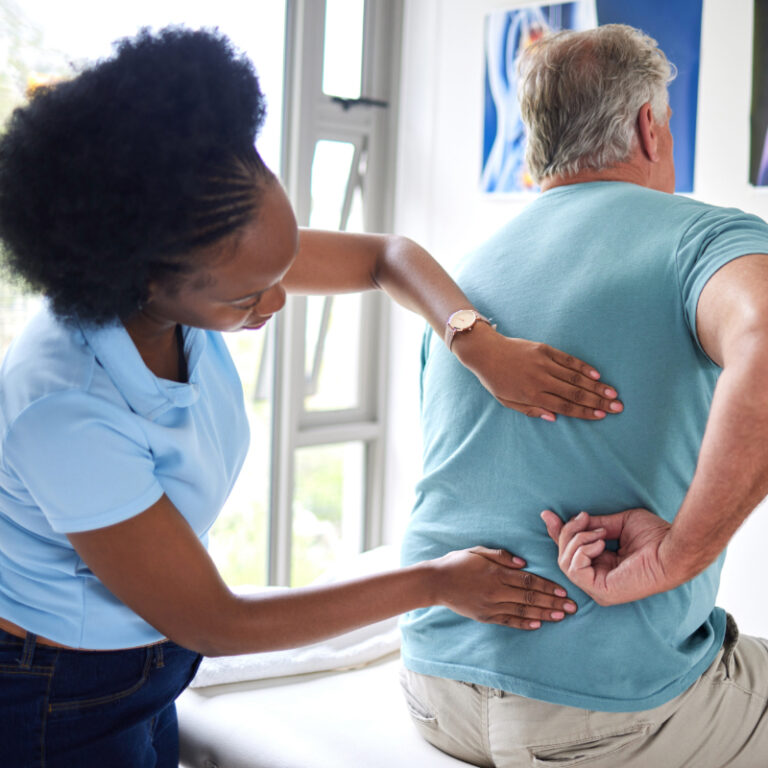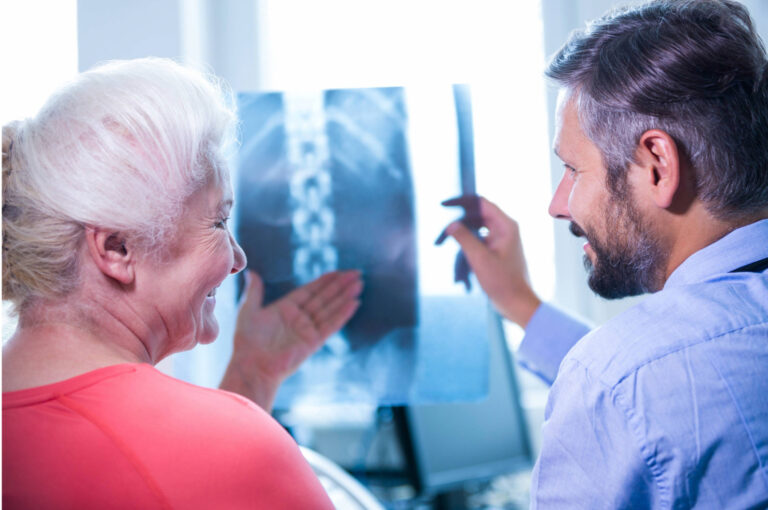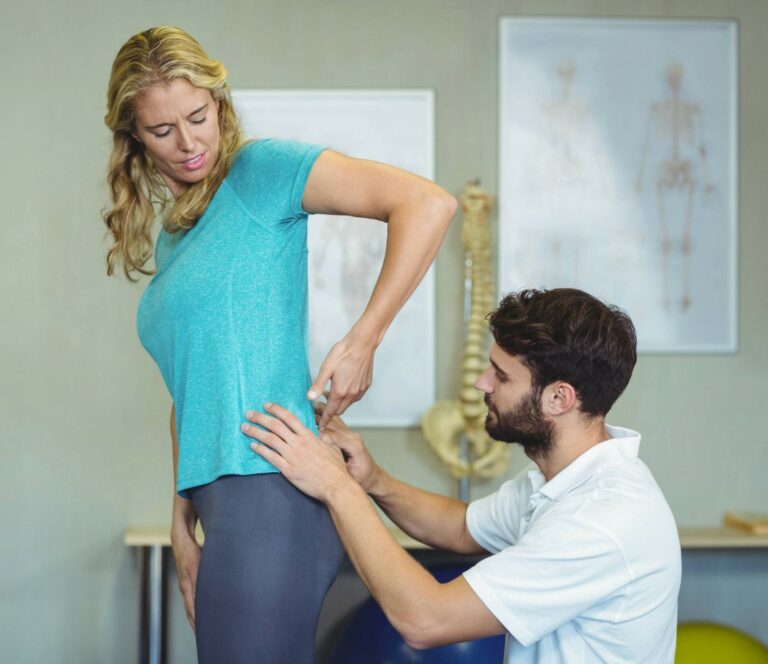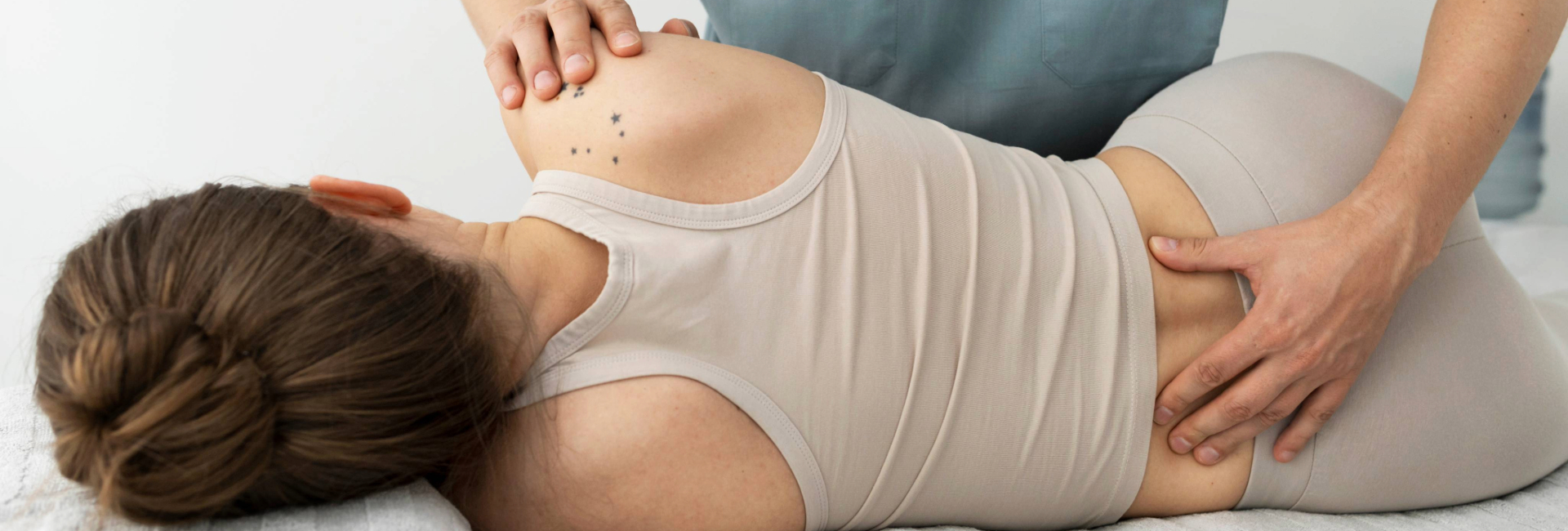It seems as though everyone is dealing with back pain these days! Well, that’s almost true – low back pain (LBP) is one of the most common causes of disability worldwide, with both prevalence and disability rates continuing to rise. Up to 84% of people will have LBP at some point in their lives. The good news is, the prognosis for acute LBP is quite good, with 72-90% of individuals achieving complete recovery within a year, and about 40% feeling pain-free within 6 weeks.
Physical therapy plays a major role in being able to achieve these favorable prognoses. Physical therapists (PTs) know more about movement (and abnormal or dysfunctional movement) than any other healthcare providers. We can identify what physiological factors and movement patterns contributed to pain or injury in the first place and prevent it from happening again. PTs are also familiar with how psychosocial factors, such as socioeconomic status, work environment, past experiences, anxiety, depression, fear, and stress affect someone’s pain to provide a holistic treatment plan.
For this reason, PTs should be first-line providers for musculoskeletal problems like LBP.
Multiple studies have shown that individuals who seek out PT first for acute LBP, rather than later or never, are 89.4% less likely to be prescribed opioids, 27.9% less likely to receive advanced imaging services (X-ray, MRI, etc.), and 14.7% less likely to visit the Emergency Department.
In the end, early PT visits decrease the unnecessary use of healthcare resources and reduce the financial burden of LBP on the patient. Additionally, long-term outcomes of PT and more invasive care (e.g. surgery) are similar, and one study showed no significant difference in pain outcomes at a 2-year follow-up.

What if my back pain means something is really wrong with me?
In part of our doctoral education, physical therapists are trained to identify the “red flags” that indicate a more serious pathology like cancer, fracture, or infection and warrant a referral back to a medical provider. The good news is these kinds of situations are rare. Plus, we know if a patient is not getting better within several weeks, this also necessitates a referral back to a medical doctor. All this to say a PT will be able to tell if someone does require medical attention.
But don’t I need an X-ray or MRI to diagnose the problem?
No! When it comes to treating LBP, imaging including X-rays and MRIs do not typically inform treatment. This is because it is very difficult to determine an exact anatomical cause of LBP. Studies that have looked at disc degeneration (DD), bulging discs, stenosis, arthritis, etc. time and time again end up with conflicting results about which changes are symptomatic or benign.
Many studies are inconclusive about what kinds of disc “injuries” led to actual pain. Disc degeneration and subsequent arthritis occur naturally and do not always result in pain.

There is an 88% chance that any individual over age 50 has DD, and even 37% of young people in their 20s have signs of DD too. One systematic review showed that as early as their 30s, people are more likely to have disc degeneration than not. Remember that imaging doesn’t tell the whole story, and many people with noticeable degenerative changes do not have symptoms at all. That means if someone does get an X-ray or MRI that shows degeneration, it isn’t as scary as it might seem, because these “abnormalities” are just normal age-related changes.
There are usually multiple factors contributing to someone’s pain experience beyond physiological factors, and for that reason a single source is often not identifiable. In fact, 85-95% of all chronic LBP has no known anatomical cause, and psychosocial issues are better predictors for the development of future LBP than abnormal imaging findings. This all goes to show that imaging usually does not inform PT intervention – we’ll generally be treating you with the same strategies whether or not you have had imaging.
Plus, there are a lot of non-structural changes that can lead to pain. Anatomy alone isn’t enough, because altered muscle timing/coordination, strength and quality of muscle, proprioception, stiffness, and even changes in brain/spinal cord communication pathways can impact pain. These are all things that can’t be seen in a static picture, but most can be assessed by those whose expertise is in movement – physical therapists.
What’s the deal with herniated discs, anyway?
Intervertebral discs are strong structures meant to withstand pressure, resist compression and twisting forces, absorb shock, and maintain spinal flexibility and stability. For a quick anatomy lesson, the outer layers are made up of 15-25 strong concentric layers of fibrocartilage, called the annulus fibrosus. The innermost portion of the disc is a gel mainly comprised of water, called the nucleus pulposus.
Herniated discs get a bad reputation, but there is strong evidence that bulging and herniated discs occur in asymptomatic individuals – about 30% of people in their 20s and 84% of people in their 80s have evidence of disc pathology but no symptoms. A whopping 75% of young adults are estimated to have asymptomatic protruding and bulging discs.
There is even more good news for people who have been diagnosed with a disc bulge or herniation. Studies show that bulges/herniations commonly reverse on their own without need for surgery. In fact, the worse the herniation, the more likely it is to get better! Remember, discs are strong and are not the same as squishable jelly donuts.

If it hurts to move, won’t exercise make my back feel worse?
Quite the opposite! With all that inconclusive evidence, the only conclusive evidence is that exercise is good for you!
Research by and large tells us that early exercise with acute low back pain is more effective than no treatment for pain reduction, function, and overall recovery. And this goes for most kinds of exercise – walking, yoga, Pilates, trunk muscle motor control training … the list goes on. Exercise in general, no matter its form, has been shown to be effective for treating LBP.
Physical therapists can confidently prescribe the type of exercise we and our patients are most comfortable with to help them get moving again.
So don’t be nervous about your PT forcing you to do jumping jacks or heavy strengthening when you are in pain; early intervention means finding gentle pain-free exercises targeted at getting you back to your usual daily movement and level of activity.
Relative rest means resting from activities that provoke your pain, but staying active in whatever ways you can.

What else can PTs do for low back pain?
Physical therapists also use manual therapy (i.e. joint mobilizations, massage) and modalities (i.e. ice, electrical stimulation) as needed to ease your symptoms and get you moving better. These interventions are valuable in addition to exercise, and we have clear practice guidelines to assist clinical decision-making regarding what manual techniques to employ. We can also help you modify your sleeping positions, work environment, lifting mechanics, etc. to reduce your pain and help you keep up with your usual activities.
So, what should I expect from my first PT visit for back pain?
Physical therapists can take the necessary time to understand your pain, environment, concerns, fears, and how your symptoms impact your life.

After our initial conversation, we will examine how you move and how it affects your back. We will use this information and work with you to establish a plan that gets you feeling better as fast as possible. Also, we can help you learn the tools to manage your own pain if it does recur in the future. With direct access available in some form in every state, most people don’t even need to consult their PCP prior to starting PT. Of course, a team approach with multidisciplinary care is always an excellent way to go about treating back pain, but you don’t need to wait to get in to see your PCP prior to starting with PT.

Got back pain?
If you are experiencing low back pain, remember that physical therapy should be your first line of defense for recovery so you can get back to doing what you enjoy!

